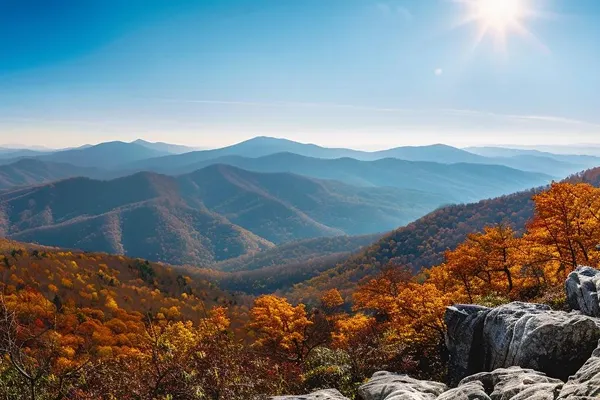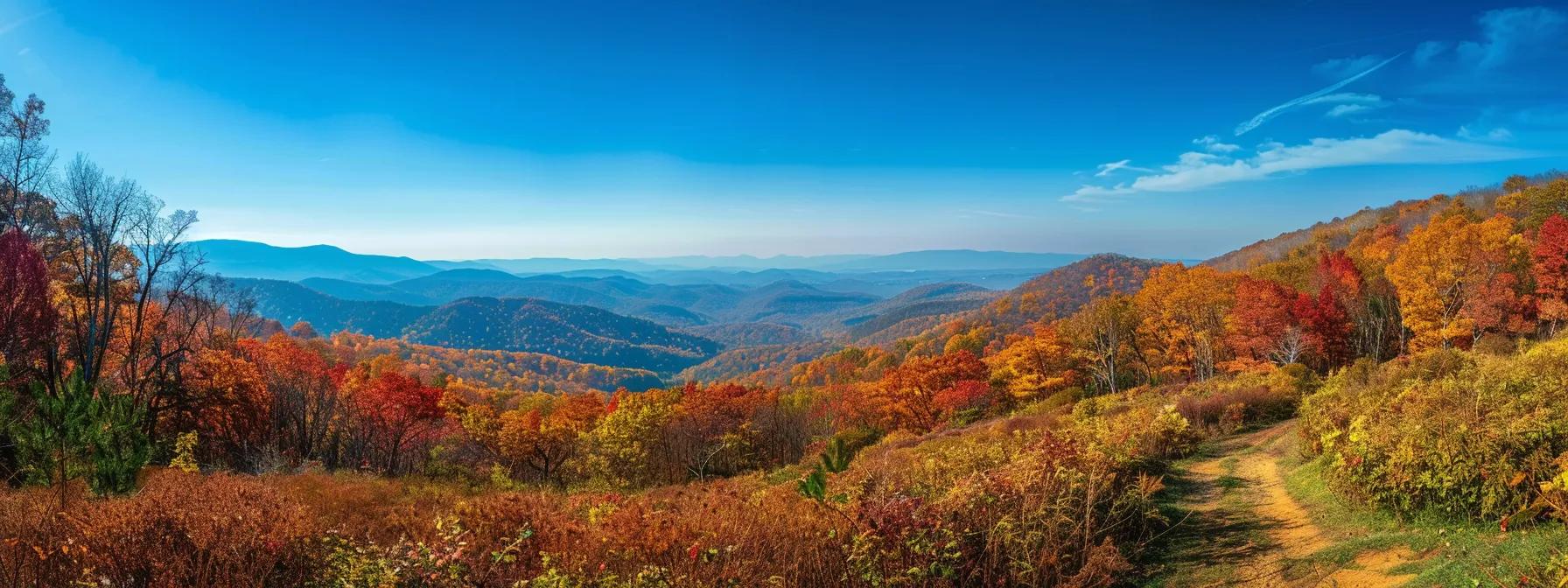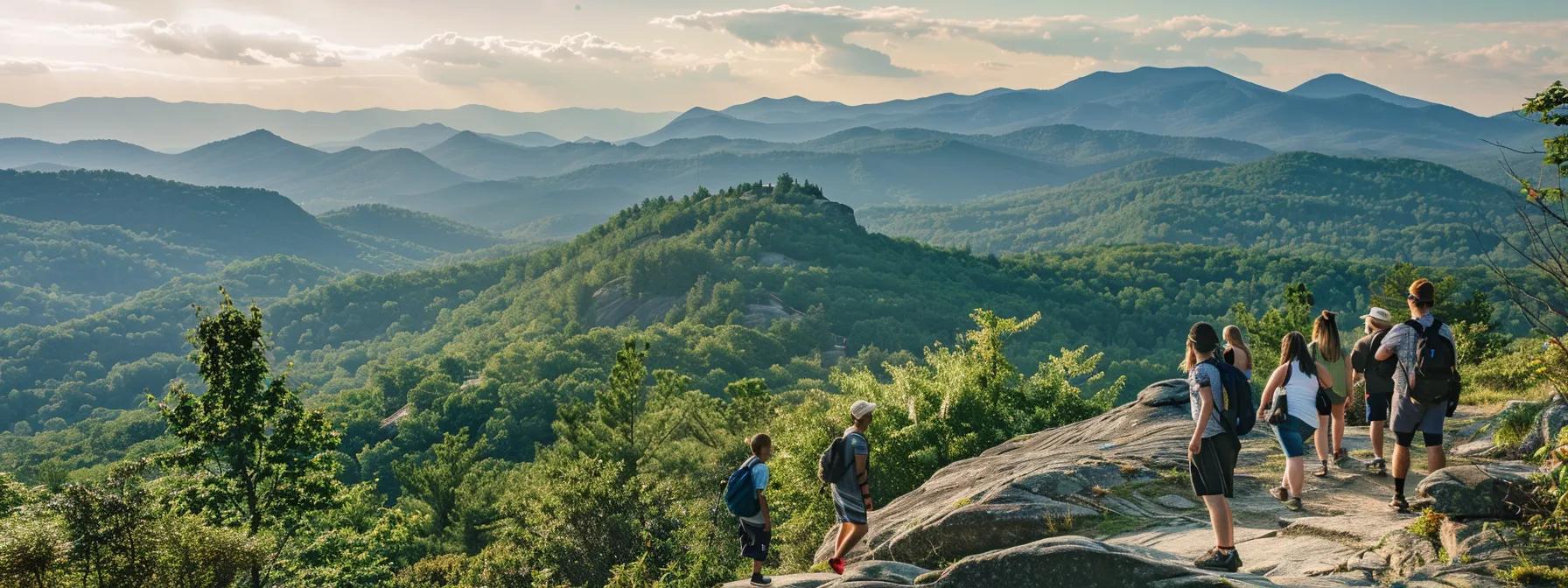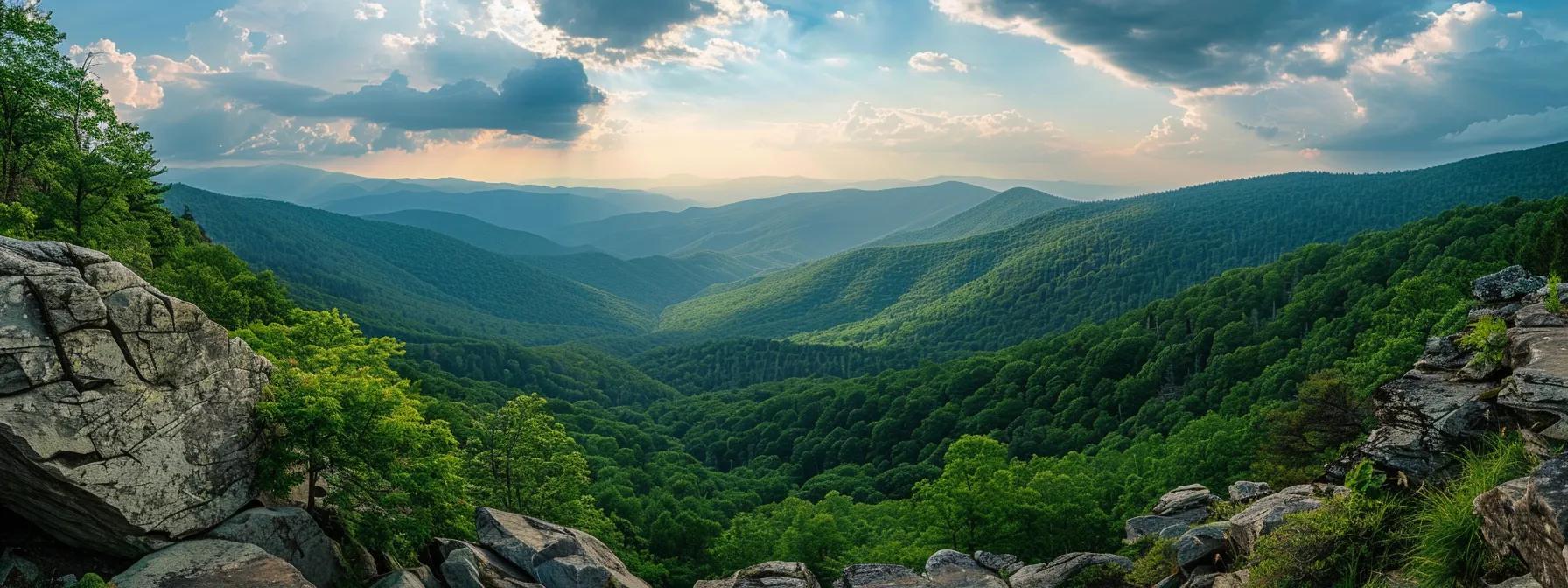
Complete Guide to Hiking Trails in the Blue Ridge Mountains
The Blue Ridge Mountains offer natural wonders, challenging trails, and stunning views, making them a top destination for family adventures and cabin escapes. Bigfoot Cabin in Blue Ridge, Georgia provides themed rentals perfect for families with kids aged 5–18. This guide answers your hiking questions—from popular trails and preparation tips to regional highlights—ensuring a safe, memorable experience. Whether you seek trails near breathtaking waterfalls like those near Grandfather Mountain or accessible routes for beginner hikers and seasoned adventurers, this guide offers step-by-step insights. Enjoy details on seasonal changes, gear recommendations, and interactive mapping resources as you plan excursions that engage children and adults alike. Read on to explore key regions, the best times to visit, and guidelines for responsible hiking.
What Are the Most Popular Hiking Trails in the Blue Ridge Mountains?
The Blue Ridge Mountains feature a varied network of trails that attract hikers of every level. Routes with waterfalls near Grandfather Mountain and panoramic views along Skyline Drive draw visitors with their diverse landscapes—from rugged cliffs and rolling valleys to meadows with wildflowers and serene streams following the leave no trace philosophy. Hikers can enjoy routes winding through dense forests and ridges with unforgettable views of peaks and summits in both the Appalachian and Great Smoky Mountains National Park areas.
Which Trails Offer Scenic Views and Waterfalls?
Many trails offer dramatic waterfalls and expansive scenic overlooks. Trails with cliff viewpoints deliver spectacular panoramas of cascading water and lush landscapes. Notable routes near Linville Falls and within Pisgah National Forest are ideal for photography and nature enjoyment. Families appreciate these natural pauses and clear trail maps make reaching top viewpoints safe and rewarding.
What Are the Top Easy, Moderate, and Strenuous Trails?
Blue Ridge hiking trails cater to various fitness levels: • Easy trails have well-marked, flat paths and minimal elevation gain, perfect for families with small children. • Moderate trails include some steep sections and rugged terrain but remain manageable with planning. • Strenuous trails involve rugged slopes, steep ascents, and uneven surfaces that require extra caution and advanced preparation. This categorization enables families to select routes that best match their energy and adventure goals.
Where Are Dog-Friendly and Family-Friendly Hiking Trails Located?
Trails that welcome both children and pets can greatly enhance outdoor experiences. Dog-friendly and family-friendly trails in Western North Carolina and Shenandoah National Park typically feature wider paths, gentle elevation changes, and picnic spots. Many areas in Pisgah National Forest and near the Appalachian Trail have been designed with safety, clear signage, water stations, and rest areas in mind to support families and pets while preserving the wilderness.
When Is the Best Time to Hike in the Blue Ridge Mountains?

The ideal hiking season in the Blue Ridge Mountains balances your family’s needs, trail accessibility, and weather conditions. Spring and fall are the most popular seasons because wildflowers and fall foliage create visually stunning landscapes with moderate temperatures and softer trail conditions. Planning ahead for seasonal trends helps avoid crowds and deal with maintenance routines, while lower humidity and vibrant sunrise or sunset views add extra appeal.
How Do Seasonal Changes Affect Trail Conditions and Accessibility?
Seasonal shifts greatly impact trail conditions: • In spring, melting snow and rains may cause muddy or slippery paths. • Summer brings warm, dry weather but can increase trail erosion. • Fall offers crisp air and vibrant foliage, though early frosts may be an issue. • Winter requires caution with icy patches and cold conditions. Adapting your gear, hydration, and pacing to these seasonal changes is key for safe hiking.
What Are the Best Months for Fall Foliage and Spring Wildflowers?
Autumn (mid-October to early November) transforms trails with red, orange, and yellow hues that delight photographers and nature lovers. Spring (late April through June) bursts with wildflower blooms against the evergreen backdrop. These periods offer comfortable weather and add cultural charm, as festivals often celebrate nature’s renewal or seasonal transitions.
Are There Any Trail Closures or Permits Required by Season?
Trail closures and permit requirements vary by season and park policies. Some trails close during inclement weather or maintenance periods. Popular areas like Shenandoah National Park and sections of the Appalachian Trail may require fees or permits during peak times. Always check official park websites or local conservation offices to secure any needed permits and avoid unexpected delays.
How Do You Prepare for Hiking Trails in the Blue Ridge Mountains?
Successful hiking in the Blue Ridge Mountains starts with careful preparation. Consider both physical readiness and logistical arrangements when planning a family outing. This includes selecting the right gear, understanding trail difficulty, researching park regulations, and planning for emergencies. Emphasizing sustainable practices and the leave no trace philosophy ensures the natural beauty of the region endures for future generations.
What Essential Gear Should You Bring for Different Trail Difficulties?
Essential gear varies by trail difficulty: • For easy trails: durable hiking shoes, sun protection, water bottles, and light snacks. • For moderate trails: layered clothing, extra water, and a basic first-aid kit. • For strenuous trails: trekking poles, detailed emergency supplies, portable navigation devices, and higher-calorie food. Additional items like rain jackets or thermal layers may be needed, so use a gear checklist for your specific route.
How Can Hikers Stay Safe on Strenuous and Remote Trails?
Safety on challenging or remote trails is crucial, especially with children. Key measures include: • Informing someone about your planned route and expected return. • Using interactive trail maps, GPS devices, or satellite messengers. • Traveling in groups at a pace that suits everyone. A robust first-aid kit and basic emergency knowledge are vital for mitigating risks from sudden weather changes, wildlife encounters, or trail hazards.
What Are the Guidelines for Responsible Hiking and Conservation?
Responsible hiking means preserving the natural environment. Key guidelines include: • Sticking to marked trails. • Packing out all trash. • Avoiding disturbance of wildlife and vegetation. Following the “leave no trace” philosophy, showing courtesy to fellow hikers, and participating in local trail maintenance support conservation efforts and ensure that these pristine areas remain accessible for years to come.
Where Are the Key Hiking Regions and Parks in the Blue Ridge Mountains?

The Blue Ridge Mountains span several regions, each offering distinct hiking experiences: • Shenandoah National Park features sweeping vistas and historic trails. • Areas surrounding Asheville, North Carolina provide a mix of urban and forested hikes. • The Great Smoky Mountains and Pisgah National Forest offer rugged terrain and abundant natural beauty. Families can choose regions based on interests such as wildlife, scenic views, or a quiet retreat.
What Trails Are Found in Shenandoah National Park?
Shenandoah National Park is famous for its extensive trail network, ranging from easy, stroller-friendly paths to strenuous ascents with panoramic valley views. With over 500 miles of trails featuring waterfalls, rugged terrain, and historical landmarks, the park, along Skyline Drive, offers a family-friendly environment supported by helpful signage and visitor centers.
Which Hiking Routes Are Popular Near Asheville, NC?
Near Asheville, trails in Pisgah National Forest and along the Blue Ridge Parkway offer diverse landscapes, from moss-covered forests and flowing streams to expansive mountain views. The region’s vibrant local culture adds a unique twist, with opportunities to enjoy local eateries and arts after a hike.
What Are Notable Trails in the Great Smoky Mountains and Pisgah National Forest?
The Great Smoky Mountains and Pisgah National Forest are renowned for quality trails such as Alum Cave and Laurel Falls in the Smokies and the Asa Abbott Loop with hikes to Looking Glass Falls in Pisgah. Emphasizing sustainable practices, these regions offer well-marked trails, rest areas, and educational programs, providing a comprehensive experience of the area’s cultural and natural heritage.
How Can You Access Trail Maps, Reviews, and Interactive Resources?
For safe and enjoyable hiking, accurate and interactive trail maps and reviews are essential. Online platforms such as AllTrails, Gaia GPS, and official park websites provide downloadable maps, real-time weather updates, and detailed trail information including lengths, elevation gains, and hazards. User reviews offer firsthand insights that help families choose the most suitable trails based on current conditions.
Where to Find Downloadable and Interactive Trail Maps?
Downloadable maps are available from federal and private agencies managing the Blue Ridge Mountains. Official park websites like those for Shenandoah National Park and Great Smoky Mountains National Park offer PDF maps, while platforms such as AllTrails and Gaia GPS provide interactive features like bookmarking and GPS tracking for quick adjustments based on real-time conditions.
How Do User Reviews and Ratings Help Choose the Right Trail?
User reviews and ratings are key in selecting a hiking trail. They provide updated insights on trail conditions, scenic highlights, and potential hazards. These reviews help distinguish family-friendly and dog-friendly routes and, combined with professional guides and official updates, assist families in choosing trails that meet all safety and enjoyment requirements.
What Are the Best Online Platforms for Blue Ridge Hiking Information?
Essential online resources for Blue Ridge hiking include AllTrails, Gaia GPS, and the National Park Service’s websites. These platforms offer extensive trail databases, community forums, and up-to-date information on route conditions, making planning efficient and ensuring reliable, current details for hikers.
What Are the Best Hiking Trails for Specific Interests in the Blue Ridge Mountains?

The Blue Ridge Mountains cater to diverse interests: • Trails with waterfalls and panoramic overlooks for stunning photography. • Pet-friendly and family-friendly routes with gentle terrain and easy access. • Extended backpacking and camping trails that offer immersive experiences in remote wilderness. Tailor your hike based on whether you value scenic beauty, physical challenge, or accessibility to create a fun and memorable adventure for your family.
Which Trails Feature Waterfalls and Scenic Overlooks?
Trails that lead to majestic waterfalls, such as those near Linville Falls, offer a visual feast with cascading water and vibrant flora. Elevated points along these trails provide unobstructed views of valleys and mountain ranges, serving as natural rest stops and educational moments about the local ecosystems.
What Are the Top Dog-Friendly and Family-Friendly Hikes?
Dog-friendly and family-friendly hikes are marked by accessible paths, minimal elevation, and ample rest areas. Many trails near Asheville and in the Shenandoah Valley include paved pathways and picnic spots, ensuring that both pets and children can safely explore and enjoy nature with clear trail markers and facilities like water fountains.
Which Trails Are Ideal for Backpacking and Camping Adventures?
For families seeking multi-day adventures, select backpacking and camping trails that traverse remote forest areas. These trails often feature designated campsites, clear water sources, and fire rings, encouraging an immersive wilderness experience and offering a chance to disconnect from technology while bonding over nature’s rugged beauty.
What Are Common Questions About Hiking Trails in the Blue Ridge Mountains?
Common family questions include hiking duration, proper packing lists, and local events. Answering these questions helps families make informed decisions, whether planning a day hike or an overnight trip, ensuring every family member—from young explorers to cautious parents—is well prepared.
How Long Does It Take to Hike Popular Trails Like the Appalachian Trail Sections?
Hiking durations vary with trail length, elevation gain, and pace. Popular Appalachian Trail sections typically take 4 to 8 hours for a family group. Factors such as frequent breaks for photography or rest, especially when hiking with children and pets, may extend the time required. Consulting trail maps and recent user reviews can help set realistic expectations.
What Should You Pack for a Day Hike Versus an Overnight Trip?
For day hikes, pack lightweight essentials including water, snacks, a basic first-aid kit, sun protection, and spare layers. Overnight trips require additional gear such as a durable backpack, tent or shelter, extra food supplies, proper cooking equipment, and thermal clothing. Tailoring your checklist to the trip duration and trail difficulty ensures safety and comfort.
Are There Any Hiking Events or Trail Maintenance Days to Join?
Community engagement is strong in the Blue Ridge hiking culture. Many local organizations offer guided hikes, family events, and trail maintenance days that educate participants on safety and environmental stewardship. Checking local park service websites and community boards will provide schedules for these enriching events.
Frequently Asked Questions
Q: What is the best time of year to see fall foliage in the Blue Ridge Mountains? A: Typically, mid-October to early November offers the best displays, with vibrant red, orange, and yellow foliage. Always check local park websites for peak viewing updates.
Q: How can families ensure their hikes are safe when including young children and pets? A: Choose family-friendly trails with gentle elevations and ample rest areas, and pack water, snacks, and a comprehensive first-aid kit. Using interactive maps and following dog-friendly guidelines further enhances safety.
Q: Are permits or entry fees required for hiking in the Blue Ridge Mountains? A: Requirements vary by region. While some areas like Shenandoah National Park may charge fees or require permits during peak times, many state-managed trails do not. Checking official websites or contacting visitor centers is recommended.
Q: What are some good strategies for navigating slippery or muddy trails during spring? A: Wear waterproof boots with good traction and consider trekking poles. Stick to well-marked paths, avoid waterlogged areas, and check weather forecasts before heading out.
Q: Do interactive trail apps provide real-time updates on trail conditions? A: Yes, apps like AllTrails and Gaia GPS offer real-time updates on weather, closures, and user reviews, which help families adjust their plans accordingly.
Q: Can you recommend any local events or guided hikes that are ideal for families in the Blue Ridge Mountains? A: Many local hiking clubs and park services offer family-friendly guided hikes and trail maintenance events. Check community boards, social media groups, or official park websites for current schedules and opportunities.
Final Thoughts
Bigfoot Cabin and the Blue Ridge Mountains provide an ideal setting for families seeking adventure and relaxation. This guide equips you with essential information—from trail difficulty and seasonal insights to gear checklists and reliable online resources—to plan a safe and enriching hiking experience. Each region in the Blue Ridge Mountains offers unique scenic beauty and engaging activities, ensuring memorable trips for kids and adults alike. Embrace the rich heritage of the Blue Ridge while enjoying modern amenities at Bigfoot Cabin, and make every outdoor adventure both educational and fun.

